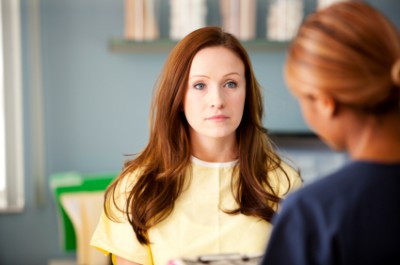Like many women, my mother faced few options when it came to her constant abdominal pain. After several years of heavy bleeding and cramping, the doctors threw their hands in the air. While she was in her late 30s, well before menopause, my mother underwent a full hysterectomy.

That was 1985. There weren’t a lot of other options, and male doctors weren’t really interested in discussing alternatives with their female patients.
Things have changed. At the forefront of this change are Dana Redick, MD, and Alan Matsumoto, MD, who lead the uterine fibroids treatment team at UVA through the new Fibroid Treatment Center that began seeing patients last February. This effort represents a whole new approach to women’s health.
As Matsumoto explains, “In the 1950s, ‘60s, and through the ‘80s, the response to a woman having pelvic pain in a male-dominated specialty was ‘you don’t need this anymore, let’s just cut it out,’ not understanding the uterus has other functions. People didn’t study it, they just cut it out, and it would cure you.”
Even today, almost 30 years later, more than 300,000 hysterectomies are performed every year in the United States, many as a way to solve symptoms of uterine fibroids. Why?
- Cure: It does cure the problem and guarantees no recurrence of symptoms related to fibroids.
- Simplicity: It’s often the easiest solution to a condition that can be pretty complex—even within one woman you can have 10 different fibroids, each different from the other.
- Patients can choose to leave their ovaries in place so they will go through menopause normally.
Because each woman’s situation is unique, one solution does not fit all. Not to mention that a hysterectomy, even for women not wanting to have more children, is major surgery with medical side effects (hormonal, physical) that requires several days in the hospital and around six weeks of recovery and missed work.
Treating Uterine Fibroids: A New Center and Approach
UVA offers other options. Not only does the new Fibroid Treatment Center offer a range of minimally invasive treatments, including focused ultrasound, but also an innovative integration of disciplines. Interventional radiologists like Matsumoto and gynecologists like Redick created a unique one-stop shop that gives each woman the ability to find out about all of her options and work with her doctor to choose the right one.
The result? Individualized treatment, personalized care, reduced risks, and empowerment of the patient to make the best choice for her.
All About Uterine Fibroids
There are several key points to remember about fibroids in the uterus. They are:
- Not cancerous or precancerous
- Extremely common
- Mostly do not cause problems; the majority of women with fibroids have none to very mild symptoms
- Rarely a factor after menopause; as the uterus shrinks, so do the fibroids and their symptoms
In cases where fibroids do cause problems, they can be very painful and disruptive.
Some women have such heavy, prolonged and/or painful menstrual cycles that they are homebound for 1-2 days a month. Fibroids can cause infertility and miscarriages.
Some women have fibroids of such size and bulk that they:
- Feel like they’re pregnant
- Need to urinate all the time
- Experience constipation
- Can’t button their pants or lay on their abdomen
- Have discomfort during sex
With all the variation in fibroid types, symptoms and treatments, and each woman’s lifestyle, one solution does not fit all.
Working Together
That’s where the Fibroid Treatment Center’s model of collaboration comes in.
Redick says, “Being an academic medical center, we get people who walk through the door who’ve tried all the routine stuff and are looking for something else.”
Women face a lot of challenges in finding the best treatment. “There’s a lot of noise out there,” Redick continues. “If you’re trying to find an answer, you go online and read, hear anecdotes, get recommended for a hysterectomy,” and have no awareness of alternatives. Often in the process a woman will see multiple specialists, have several appointments and get totally confused.
Redick, Matsumoto and their colleagues work together in teams, seeing patients “side by side, so they’re not hearing conflicting stories. This empowers women to make the best decision for their personal situation.”
Redick is excited about what this new approach offers. “What I really like about our clinic is not only giving feedback to the patient immediately, but the fact that we talk as a team both before and after meeting with a patient. We meet a patient knowing what each team has to offer and develop a recommended treatment together. Sometimes that plan has to be reworked when she explains what she wants or what is important to her. Then we meet after to talk again and plan the treatment.”
Treatment Options for Uterine Fibroids
UVA remains the only center in the region offering all of the available options, including minimally invasive procedures that reduce recovery time:
- Medications (hormonal and non-hormonal)
- Focused ultrasound
- Endometrial ablation
- Uterine artery embolization (UAE)
- Myomectomy
- Hysterectomy
Explore all the treatment options for uterine fibroids.
Interested?
- We offer easy parking and access at the Midlife Center at Northridge Medical Center.
- Call to make an appointment. You don’t need a referral to get a consultation.